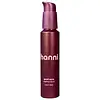What's inside
What's inside
 Key Ingredients
Key Ingredients

 Benefits
Benefits

 Concerns
Concerns

 Ingredients Side-by-side
Ingredients Side-by-side

Sodium Cocoyl Isethionate
CleansingHydrogenated Vegetable Oil
EmollientPolyglyceryl-4 Laurate
EmulsifyingWater
Skin ConditioningGlycerin
HumectantBenzyl Benzoate
AntimicrobialEucalyptus Globulus Leaf Oil
PerfumingButyrospermum Parkii Butter
Skin ConditioningTetrasodium Glutamate Diacetate
Citrus Aurantium Dulcis Peel Oil
MaskingMentha Arvensis Leaf Oil
MaskingMentha Piperita Oil
MaskingMaltodextrin
AbsorbentAloe Barbadensis Leaf Juice Powder
Skin ConditioningSaccharomyces Ferment Filtrate
HumectantLimonene
PerfumingParfum
MaskingChamomilla Recutita Flower Extract
MaskingHydrolyzed Gardenia Florida Extract
AntioxidantPhenethyl Alcohol
MaskingSodium Cocoyl Isethionate, Hydrogenated Vegetable Oil, Polyglyceryl-4 Laurate, Water, Glycerin, Benzyl Benzoate, Eucalyptus Globulus Leaf Oil, Butyrospermum Parkii Butter, Tetrasodium Glutamate Diacetate, Citrus Aurantium Dulcis Peel Oil, Mentha Arvensis Leaf Oil, Mentha Piperita Oil, Maltodextrin, Aloe Barbadensis Leaf Juice Powder, Saccharomyces Ferment Filtrate, Limonene, Parfum, Chamomilla Recutita Flower Extract, Hydrolyzed Gardenia Florida Extract, Phenethyl Alcohol
Alternatives
Ingredients Explained
These ingredients are found in both products.
Ingredients higher up in an ingredient list are typically present in a larger amount.
Parfum is a catch-all term for an ingredient or more that is used to give a scent to products.
Also called "fragrance", this ingredient can be a blend of hundreds of chemicals or plant oils. This means every product with "fragrance" or "parfum" in the ingredients list is a different mixture.
For instance, Habanolide is a proprietary trade name for a specific aroma chemical. When used as a fragrance ingredient in cosmetics, most aroma chemicals fall under the broad labeling category of “FRAGRANCE” or “PARFUM” according to EU and US regulations.
The term 'parfum' or 'fragrance' is not regulated in many countries. In many cases, it is up to the brand to define this term.
For instance, many brands choose to label themselves as "fragrance-free" because they are not using synthetic fragrances. However, their products may still contain ingredients such as essential oils that are considered a fragrance by INCI standards.
One example is Calendula flower extract. Calendula is an essential oil that still imparts a scent or 'fragrance'.
Depending on the blend, the ingredients in the mixture can cause allergies and sensitivities on the skin. Some ingredients that are known EU allergens include linalool and citronellol.
Parfum can also be used to mask or cover an unpleasant scent.
The bottom line is: not all fragrances/parfum/ingredients are created equally. If you are worried about fragrances, we recommend taking a closer look at an ingredient. And of course, we always recommend speaking with a professional.
Learn more about Parfum